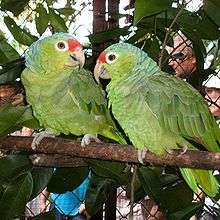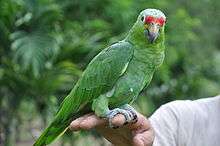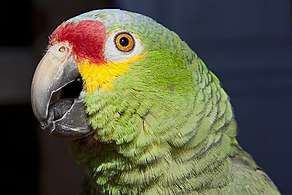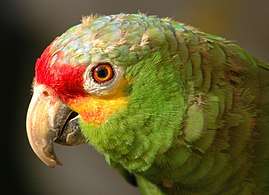Red-lored amazon
The red-lored amazon or red-lored parrot (Amazona autumnalis) is a species of amazon parrot, native to tropical regions of the Americas, from eastern Mexico south to Ecuador where it occurs in humid evergreen to semi-deciduous forests up to 1,100 m altitude. It is absent from the Pacific side of Central America north of Costa Rica. Not originally known from El Salvador, a pair - perhaps escaped from captivity - nested successfully in 1995 and 1996 in the outskirts of San Salvador[2] and the species might expand its range permanently into that country in the future.[3] This species has also established feral populations in several California cities.[4]
| Red-lored amazon | |
|---|---|
 | |
| At Xcaret Eco Park, Mexico | |
| Scientific classification | |
| Kingdom: | Animalia |
| Phylum: | Chordata |
| Class: | Aves |
| Order: | Psittaciformes |
| Family: | Psittacidae |
| Genus: | Amazona |
| Species: | A. autumnalis |
| Binomial name | |
| Amazona autumnalis | |
| Synonyms | |
|
Psittacus autumnalis Linnaeus, 1758 | |


_feeding.jpg)
feeding in the wild, Panama
Description
The red-lored amazon is 32–35 cm (13 in) in length, with a weight of 310–480 g. The plumage is primarily green, with a red forehead and, in some subspecies, yellow cheeks (sometimes with red spots). The crown is blue. Adult males and females do not differ in plumage. Juveniles have less yellow on the cheeks, less red on the forehead, and dark irises.
Taxonomy
There are three subspecies:[5]
- Amazona autumnalis autumnalis (Linnaeus, 1758). Caribbean coasts from eastern Mexico south to northern Nicaragua.
- A. a. salvini (Salvadori, 1891). Northern Nicaragua south to Colombia and Venezuela.
- A. a. lilacina (Lesson, 1844), the lilacine amazon. Western Ecuador.
 A vocalizing
A vocalizing Head plumage of adults is characteristic, but the cheek color varies among subspecies, with this, A. a. autumnalis, being the only with a bright yellow patch
Head plumage of adults is characteristic, but the cheek color varies among subspecies, with this, A. a. autumnalis, being the only with a bright yellow patch A. a. lilacina is local within its already small range, leading to concerns about its status
A. a. lilacina is local within its already small range, leading to concerns about its status_in_flight.jpg) A. a. salvini
A. a. salvini
in flight, Panama
Behavior
Food and feeding
Their food includes fruits,[6] nuts and seeds. Like all parrots, red-lored amazons need a varied diet consisting of high quality pellets, a quality seed mix, and daily servings of fresh, bird-safe fruits and vegetables.
Breeding
The red-lored amazon nests in tree cavities. The eggs are white and there are usually three or four in a clutch. The female incubates the eggs for about 26 days and the chicks leave the nest about 60 days after hatching.[7]
Status
In some areas, notably parts of Mexico and Venezuela, the red-lored amazon has become rare through trapping for the cagebird trade. On the other hand, it seems to be able to adapt to human-altered habitat to a considerable degree.[3]
Aviculture
Red-lored amazons are fairly common pet parrots in the Americas. They can be devoted pets and some make fairly good talkers. Like most amazon parrots they often have a tendency to vocalize loudly, and sometimes to bite. Their behavior ranges from being quiet and curious to being aggressive, this can all be changed by basic training when the bird is of a young age. Red-lored amazons can grow up to 13 inches in length. While they largely feast on seeds, fruits and nuts, avocados and eggplants are poisonous to them and can kill them. Their average life span is up to 80 years.
References
- BirdLife International (2012). "Amazona autumnalis". IUCN Red List of Threatened Species. 2012. Retrieved 26 November 2013.CS1 maint: ref=harv (link)
- At San Jacinto Hill, 13°42'N 89°08'W: Herrera et al. (2006).
- Herrera et al. (2006)
- "Flock Information". California Flocks. Retrieved 7 December 2013.
- "Zoological Nomenclature Resource: Psittaciformes (Version 9.004)". www.zoonomen.net. 2008-07-05.
- E.g. of Cymbopetalum mayanum (Annonaceae), Gumbo-limbo (Bursera simaruba), mango (Mangifera indica), figs (Ficus spp.) and palo de hule (Castilla elastica): Herrera et al. (2006), Forster (2007).
- Alderton, David (2003). The Ultimate Encyclopedia of Caged and Aviary Birds. London, England: Hermes House. p. 233. ISBN 1-84309-164-X.
- Collar, Nigel J. (1997): 313. Red-lored Amazon. In: del Hoyo, Josep; Elliott, Andrew & Sargatal, Jordi (eds.): Handbook of Birds of the World, Volume 4 (Sandgrouse to Cuckoos): 469–470, Plate 54. Lynx Edicions, Barcelona. ISBN 84-87334-22-9
- Foster, Mercedes S. (2007): The potential of fruiting trees to enhance converted habitats for migrating birds in southern Mexico. Bird Conservation International 17(1): 45–61. doi:10.1017/S0959270906000554 PDF fulltext
- Herrera, Néstor; Rivera, Roberto; Ibarra Portillo, Ricardo & Rodríguez, Wilfredo (2006): Nuevos registros para la avifauna de El Salvador. ["New records for the avifauna of El Salvador"]. Boletín de la Sociedad Antioqueña de Ornitología 16(2): 1-19. [Spanish with English abstract] PDF fulltext
External links
| Wikimedia Commons has media related to Amazona autumnalis. |
- Species profile - World Parrot Trust
